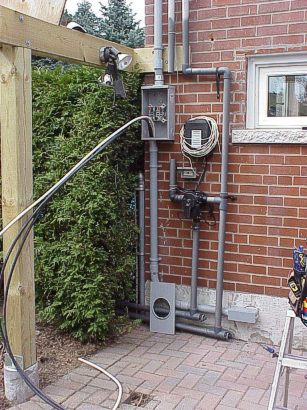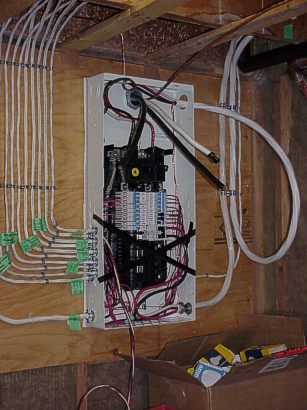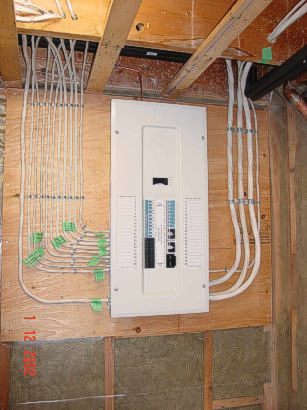| Home |
| What's New |
| Videos |
| Pictures |
| Donations |
| Webcams |
| Sponsors |
| About us |
| Contact |
| Archives |
| How we do it |
| Quick facts |
| Awards |
| Comments |
| Credits |
| FAQs |
| Lost/Found |


Power Distribution
|
Setup Status Power Distribution Computer Control Buffer Boards Channel Boxes Snowball Fight Driveway Arches |
Donation Box Grass Grid Roof Grid LED Mega Tree Trees Leaping Arches |
This is really where it all begins. The display can draw over 38 000 watts of power at peak periods which is equivalent to 317 amps at 120 volts. This is serious power, which is why it must be supplied safely. In the summer of 2002 we upgraded our main entrance service from 100 amps to 200 (200 amps at 240V, which is 400 amps @120v). Of course, after we completed the installation, our work was inspected by the Electrical Safety Authority. Two 100 amp sub-panels have been designated for the display, and are shown later on.
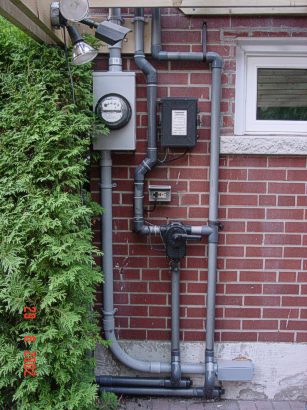 |
Once inspections were complete, the utility company made the final connections and installed the meter. |
| There are two PVC pull boxes shown here, each supplied by their own sub-panel. | |
| The Ontario Electrical Code points out that all wiring within 1.5 meters from the ground must be protected, which is why we used PVC conduit. Above the boxes are ground fault interrupter circuit outlets, each on their own dedicated 15 amp, 120v circuit. Having ground fault outlets is EXTREMELY important when using electricity that has the potential of coming in contact with water. The ground fault outlets basically compare the amount of current being sent out on the "HOT" line, with the returning current on the "NEUTRAL" line. Under normal conditions, these currents should be equal. If the ground fault outlet senses that more current is going out on the "HOT" than is returning on the "NEUTRAL", it "trips", cutting off the supply. This protects people from getting electrocuted in the event that they come in contact with a live source. For example: If a person came in contact with a "HOT" line, the current would flow through their body, rather than returning on the "NEUTRAL" line. The ground fault detector would sense this leakage, trip, and prevent electrocution.
Electric shock may cause burns of varying seriousness, stoppage of breathing, unconsciousness, cardiac arrest, or death. If a 60 Hz alternating current passes through a person from hand to hand or hand to foot, the results depend on the amount of current: 1mA: The shock will be felt. 10mA: The shock is severe enough to paralyze muscles and a person may be unable to release the conductor. 100mA: The shock is usually fatal if it lasts more than 1 second. The resistance of your body will vary. If the skin is dry and unbroken, body resistance will be as high as 500Kohms. If the skin is wet, however, body resistance can drop to as low as 300ohms. A voltage of only 30V can cause a fatal current to flow, so any circuit with more than 30V must be considered dangerous. Class A ground faults are set to trip if there is more than 5mA of leakage (we are using class A). |
|
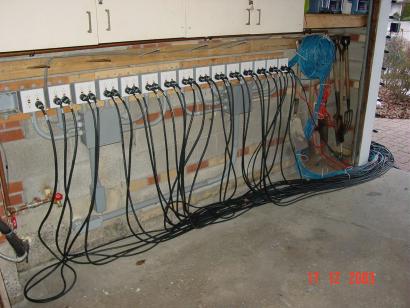 |
This is what it looks like when all connected. You can see the data wires on the right where they enter the house to connect to the buffer boards. |
